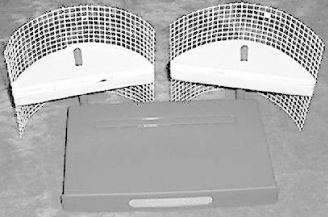Hack 70 Deep Dish Cylindrical Parabolic Reflector
|
This simple design provides high gain without pigtails or modifying your AP. I needed a parabolic reflector to eliminate off-property coverage. This design can reduce signal from some areas while enhancing signal in other areas. I designed this reflector to be installed in outdoor enclosures with WAP-11 access points, but it is becoming quite popular with people building indoor LANs, as well as with people building very short point-to-point links. This design offers very high performance and easy availability (scissors, tape, cardboard, tin foil, and 20 minutes, and you are in business). See it in action in Figure 5-1. Figure 5-1. Add a reflector without modifying the AP. This antenna is so easy to make, tune, and install, and it performs so well, that it is foolish not to try one before electing to purchase a commercial antenna, if for no other reason than you can check to see whether you are purchasing enough commercial antenna gain to make the link you want to make. Advantages over other antennas:
This design can easily complete links up to one kilometer by sitting two WAP-11s in windows at each end of a link with clean line of sight. The 6-inch version of the antenna gives you about 10 to 12 dB of gain over the stock antenna. With a WAP11, this equates to approximately 27 to 33 dB of Effective Isotropically Radiated Power (EIRP). This means you wind up with an apparent power in the favored direction between 500 mw and 2 Watts. Of course, that gain has to come from somewhere. It comes from the back side of the reflector, so power that is normally transmitted in that direction is "bounced" forward. That feature of this antenna can be used to enhance the privacy of your wireless network, which was my reason for designing it in the first place. The rest is just gravy (but it is very real and rather tasty gravy). The approximate radiation pattern of a 9-inch reflector is shown in Figure 5-2. Figure 5-2. Approximate radiation patter for a 9" reflector. To build this reflector, you can use the sample template in the Appendix, or download the original reflector template from http://www.freeantennas.com/projects/template/parabolic.pdf. The drawing can be scaled using a copy machine to make a dish of any reasonable size. The gain computations for various sizes of the dish are also provided on the web site, as well as rough graphs showing beam width and gain/frequency. This reflector is frequency independent, meaning it works with any wireless gear, on any band. There is a square drawn upon the diagram. It will help you to ensure that your scaling does not corrupt the aspect ratio of the template. In other words, if the square is still square after you enlarge or reduce the template, you still have a good template. Focal length varies proportionally with the size of the dish, so the focal point is also shown in the drawings. Positioning of the feed point (focal point) is the most critical aspect of a deep dish parabolic. Errors of 1/4" or more are unacceptable at these frequencies. It may help to "fiddle" with the positioning as small irregularities (~1/4" or greater) will move the focal point slightly. If the dipole is not in the focal point, you will lose gain. Parabolic reflectors also lose gain if your finished reflector varies much from the correct curve. The reflector is designed to be fed by a dipole, which is why it is not circular. A dipole is long and cylindrical, while the focal point on a circular dish is circular. The focal point on this design is a cylinder. Many access points (such as the WAP-11) use one or more dipoles as their antenna. This reflector is the optimal shape for such an antenna. Some units, such as the WET-11, do not use dipoles as their antenna. You can download a modified template for the WET-11 at the address listed at the end of this hack. The reflector should be made from a piece of square material to shape the curve. If you need to reduce height for packaging reasons, a shorter antenna will work but will lose roughly 3 dB for each halving of reflector height. It is also important to try to get the dipole lined up in the center of the reflector. Front-to-back ratio is a measurement of how well a directional antenna rejects interference from directions other than the desired direction. The front-to-back ratio with this antenna depends upon the size of the wire mesh you use to make the antenna. Finer mesh yields only slightly better gain but yields much better front-to-back ratio. Modeling shows the F/B ratio to be better than ~25 dB if you use 1/4" or smaller mesh. My calculated gain figures presume the reflector is 55 percent efficient. If you use a solid sheet of aluminum or copper as your reflector, your gain figures may be a little bit higher than these. The radiation pattern is narrower in the vertical plane than the horizontal plane. People have made good reflectors from Pringles cans, large tin cans, wire screen, aluminum sheet, and tin roofing material. Any flat metal surface or screen, such as tinfoil taped to cardboard, will work. You can build one of these in less than a half an hour using an old shoe box and a roll of tin foil. The original article that this Hack is based on is available online at http://www.freeantennas.com/projects/template/index.html. Michael Erskine |
EAN: N/A
Pages: 158